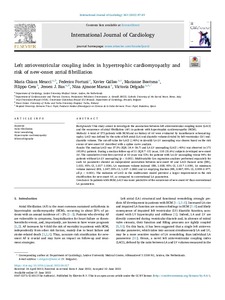Left atrioventricular coupling index in hypertrophic cardiomyopathy and risk of new-onset atrial fibrillation
Crea Filippo; Delgado Victoria; Bootsma Marianne; Marsan Nina Ajmone; Galloo Xavier; Fortuni Federico; Meucci Maria Chiara; Bax Jeroen J
https://urn.fi/URN:NBN:fi-fe2022081154494
Tiivistelmä
Backgrounds
This study aimed to investigate the association between left atrioventricular coupling index (LACI) and the occurrence of atrial fibrillation (AF) in patients with hypertrophic cardiomyopathy (HCM).
Methods
A total of 373 patients with HCM and no history of AF were evaluated by transthoracic echocardiography. LACI was defined by the ratio of left atrial (LA) end-diastolic volume divided by left ventricular (LV) end-diastolic volume. The cut-off value for LACI (≥40%) to identify LA-LV uncoupling was chosen based on the risk excess of new-onset AF described with a spline curve analysis.
Results
The median LACI was 37.5% (IQR: 24.4–56.7) and LA-LV uncoupling (LACI ≥40%) was observed in 171 (45.8%) patients. During a median follow-up of 11 (IQR 7–15) years, 118 (31.6%) subjects developed new-onset AF. The cumulative event-free survival at 10 years was 53% for patients with LA-LV uncoupling versus 94% for patients without LA-LV uncoupling (p < 0.001). Multivariable Cox regression analyses performed separately for each LA parameter showed an independent association between new-onset AF and LACI (hazard ratio [HR], 1.021; 95% CI, 1.017–1.026), LA maximum volume indexed (HR, 1.028; 95% CI, 1.017–1.039), LA minimum volume indexed (HR, 1.047; 95% CI, 1.037–1.060) and LA emptying fraction (HR, 0.967; 95% CI, 0.959–0.977, all p < 0.001). The inclusion of LACI in the multivariate model provided a larger improvement in the risk stratification for new-onset AF, as compared to conventional LA parameters.
Conclusion
In patients with HCM, LACI was more predictive of the occurrence of new-onset AF than conventional LA parameters.
Kokoelmat
- Rinnakkaistallenteet [19207]
